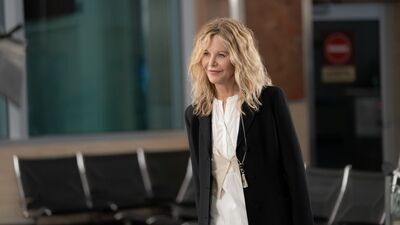With her second feature directorial effort, “What Happens Later,” Ryan returns to the romantic comedy world. Based on the play Shooting Star by Steven Dietz, along with directing, Ryan co-wrote the script and is one of the film’s two leads. She stars as Willa, a New Agey woman from Austin on her way to Boston who runs into her ex, Bill (David Duchovny, a master of effortless deadpan charm), after the two are stranded in a small airport waiting for connections delayed by a snowstorm. Ryan’s film is filled with magical realism as these two ex-lovers learn to slow down and reconnect with each other, themselves, and the things that are good in life.
For this month’s Female Filmmakers in Focus column, RogerEbert.com spoke to Ryan over Zoom about creating magical environments, liminal spaces, working with David Duchovny, and what she learned about directing romantic comedies from Nora Ephron.
How did you come across this play, and what about it spoke to you?
The playwright had written a draft as a screenplay, and that’s the iteration that came to me. It was right during the lockdown. It seemed like a very doable thing because it’s just two people and one environment that was mostly empty. So it piqued my imagination because it seemed doable, especially on a small budget. It just kept evolving and evolving, evolving. I got more involved with the writing, and then David Duchovny came on board, and then we got financing. I loved the idea of this magical world. I had been to Bentonville a couple of times and had gone to the Crystal Bridges Museum there. When I first read the script, I imagined it in a world like that. Not an airport, but just in a magical environment. Then we got to shoot there. Unbelievable. We got to shoot in that town, which I loved. That was the evolution. It just kept baiting me and hooking me and baiting me.
You have these two locations, the Crystal Bridges Museum and the Northwest Arkansas National Airport, that you combine seamlessly. Can you talk about that?
It was a liminal environment, meaning it’s a transitional environment that was dreamlike, somewhere between a memory and a dream, which is how you might think of an airport. Although an airport technically is a liminal environment because it is a space of transition. We wanted to slowly induct the audience into this magical world. And using both those elements, we were able to do that. And then, of course, when night falls, and again, given our limited resources, we had to make shiny floors, almost like they were walking on water. So we shot away from the windows, but when we did see a window, we have it snowing.
